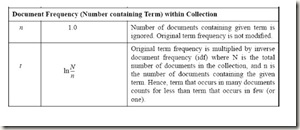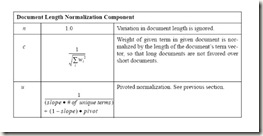作者:finallyliuyu 转载使用等请注明出处
在上一篇博文《Kmeans聚类之特征词选择DF》中我们已经给出了特征词选择的代码,这里我们将给出建立文档向量模型的代码,以及将文档向量模型写成Weka数据格式的代码。关于Weka数据格式等相关内容,请见:教程。
首先我们给出写Arff头文件的代码
void Preprocess::WriteHeadArff()
{
ofstream ofile(arffFileAddress,ios::binary);
ofile<<"@relation aticle"<<endl;
ofile<<"\n";
vector<string> myKeys=GetFinalKeyWords();
for(vector<string>::iterator it=myKeys.begin();it!=myKeys.end();it++)
{
//string temp="@attribute "+"'"+(*it)+"'"+" real";
string temp="";
temp+="@attribute ";
temp+="'";
temp+=*(it);
temp+="'";
temp+=" real";
/*strcpy(temp,"@attribute ");
strcpy(temp,"'");
strcpy(temp,*(it));
strcpy(temp,"'");
strcpy(temp," real");*/
ofile<<temp<<endl;
}
ofile<<"\n"<<endl;
ofile<<"@data"<<endl;
ofile.close();
}
下面重点介绍采用TF-IDF权重建立文档向量模型:
在给出代码之前先简要介绍下什么是TF,DF
对于一个特定的Term t
TF,指的是它在吗某一篇文章中出现的次数;
DF,指的是整个文档集合中出现该词的文章篇数;
文档向量模型(Vector Space Model):向量。向量的属性为用《Kmeans聚类之特征词选择DF》中的特征词选择方法选定的特征词。
整个文档集合的VSM模型实际上是以矩阵的格式保存的。矩阵的每一行,代表一篇文章,是一个文档向量。
TF-IDF模型有很多权重计算模式:(注意:以下截图来自于计算所王斌老师的课件《现代信息检索》)在这里顺便给大家介绍一本十分不错的书《信息检索导论》 (Introduction to Information Retrieval)原版第一作者为斯坦福大学计算机语言学副教授Christopher D. Manning。该书由王斌老师翻译成中文,现在已经出版。
TF权重计算模式:
IDF权重计算模式:
归一化方式:
考虑到一篇文章可能完全不含有我们用DF选择法选择的特征词。
那么这篇文章的VSM就是{0,0,0,..0}
为了避免产生这种类型的稀疏数据,我采用的TF-IDF计算模式为
a-l-c。
大家对应上面三个表找一下,就找到相应的计算公式了。
下面开始建立文档向量模型:
获得每个特征词对应的maxTF和DF:
ector<pair<int,int> >Preprocess::GetfinalKeysMaxTFDF(map<string,vector<pair<int,int>>> &mymap)
{
vector<pair<int,int> >maxTFandDF;
vector<string>myKeys=GetFinalKeyWords();
for(vector<string>::iterator it=myKeys.begin();it!=myKeys.end();it++)
{
int DF=mymap[*it].size();
int maxTF=0;
for(vector<pair<int,int> >::iterator subit=mymap[*it].begin();subit!=mymap[*it].end();subit++)
{
if(subit->second>maxTF)
{
maxTF=subit->second;
}
}
maxTFandDF.push_back(make_pair(maxTF,DF));
//find_if(mymap[*it].begin(),mymap[*it].end(),
}
return maxTFandDF;
}
************************************************************************/
/* 文档向量模型归一化 */
/************************************************************************/
vector<pair<int,double> >Preprocess::NormalizationVSM(vector<pair<int,double> > tempVSM)
{
double sum=0;
for(vector<pair<int,double> >::iterator vsmit=tempVSM.begin();vsmit!=tempVSM.end();++vsmit)
{
sum+=pow(vsmit->second,2);
}
for(vector<pair<int,double> >::iterator vsmit=tempVSM.begin();vsmit!=tempVSM.end();++vsmit)
{
vsmit->second/=sqrt(sum);
}
return tempVSM;
}有了上面的辅助函数,那么我们可以一边对文档集合建立文档向量模型,一边写arff文件的data部分了。
首先还要给出两个辅助函数,分别完成浮点数和整数字符串化的功能
/************************************************************************/
/* 将整数转化成字符串 */
/************************************************************************/
string Preprocess::do_fraction(int val)
{
ostringstream out;
out<<val;
string str= out.str(); //从流中取出字符串
str.swap(string(str.c_str()));//删除nul之后的多余字符
return str;
}/************************************************************************/
/* 将浮点数转化成指定精度的字符串 */
/************************************************************************/
string Preprocess::do_fraction(double val,int decplaces)
{
//int prec=numeric_limits<double>::digits10;
char DECIMAL_POINT='.';
ostringstream out;
//out.precision(prec);
out<<val;
string str=out.str();
size_t n=str.find(DECIMAL_POINT);
if((n!=string::npos)&&n+decplaces<str.size())
{
str[n+decplaces]='\0';
}
str.swap(string(str.c_str()));
return str;
}
将一篇文档的VSM字符串化的函数:
************************************************************************/
/* 单个文档向量模型字符串化 */
/************************************************************************/
string Preprocess::FormatVSMtoString(vector<pair<int,double> > tempVSM)
{
string ret="{";
int commaindication=0;
for(vector<pair<int,double> >::iterator vsmit=tempVSM.begin();vsmit!=tempVSM.end();++vsmit)
{
ret+=do_fraction(vsmit->first)+" "+do_fraction(vsmit->second,8);
if(commaindication<tempVSM.size()-1)
{
ret+=",";
}
commaindication++;
}
ret+="}";
return ret;
}
下面的函数调用上面的FormatVSMtoString 填写arff文件的data字段
/************************************************************************/
/* 将实验数据写成arff @data格式 */
/************************************************************************/
void Preprocess::VSMFormation(map<string,vector<pair<int,int>>> &mymap)
{ int corpus_N=endIndex-beginIndex+1;
ofstream ofile1(articleIdsAddress,ios::binary);//保存文章编号的文件
ofstream ofile2(arffFileAddress,ios::binary|ios::app);
vector<string> myKeys=GetFinalKeyWords();
vector<pair<int,int> >maxTFandDF=GetfinalKeysMaxTFDF(mymap);
for(int i=beginIndex;i<=endIndex;i++)
{ vector<pair<int,double> >tempVSM;
for(vector<string>::size_type j=0;j<myKeys.size();j++)
{
//vector<pair<int,int> >::iterator findit=find_if(mymap[myKeys[j]].begin(),mymap[myKeys[j]].end(),PredTFclass(i));
double TF=(double)count_if(mymap[myKeys[j]].begin(),mymap[myKeys[j]].end(),PredTFclass(i));
TF=0.5+0.5*(double)TF/(maxTFandDF[j].first);
TF*=log((double)corpus_N/maxTFandDF[j].second);
if(TF!=0)
{
tempVSM.push_back(make_pair(j,TF));
}
}
if(!tempVSM.empty())
{
tempVSM=NormalizationVSM(tempVSM);
string vsmStr=FormatVSMtoString(tempVSM);
ofile1<<i<<endl;
ofile2<<vsmStr<<endl;
}
tempVSM.clear();
}
ofile1.close();
ofile2.close();
}至此文档向量模型建立模块的代码已经介绍完毕。
未完,待续,下次我们将介绍如何从weka获得计算出的聚类中心,完成文本聚类。


